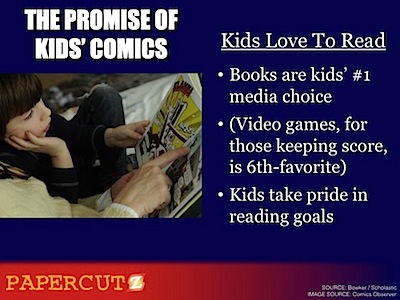Speaking of ComicsPRO, here’s a link I found in the coverage: a slideshow put together by Papercutz marketing director Jesse post on the power and potential of kids’ comics. The slideshow is embedded above but he does a walk-through on his blog and although Papercutz-centric material is there, it’s really big on stats and charts and studies. For instance:
Children’s publishing is astonishingly digital-proof. The commonly accepted average digital/print split for adult trade publishing is 50/50, and leaning more towards digital every day. In children’s trade publishing, it’s 10/90! I’ve seen major best-selling children’s books move 1% of their print sales in digital. A Papercutz book that achieves 3% of its print sales in digital is a significant bump.
This does back up studies that I’ve seen—but I’ve also had the proud parent of a 1-year-old girl show me a video (on his iPhone) of her using an iPad with complete facility. Although a super-race of digital-only Eloi kids is probably on its way, it won’t be here for a while—too many of today’s parents were raised on books, and until that preference cycles out completely, it won’t be gone.
But it does back up something I’ve been feeling over the last few months…there’s going to be a “third wave” of comics used for educational purposes. There’s a small, dedicated core of comics people who want this to happen, but although small in number, they are no smaller than the ones who drove other comics retailing and marketing revolutions. And this time, we have a lot of teachers and librarians on our side. It may not be an obvious step for comics, the art form, but if it comes through it could provide even more stability.
A lot is happening.





“This does back up studies that I’ve seen—but I’ve also had the proud parent of a 1-year-old girl show me a video (on his iPhone) of her using an iPad with complete facility. ”
Completely agree, and it’s worth clarifying that the above was more of an observation of what’s happening now (something that should be REALLY interesting to brick-and-mortar retailers!) and not any kind of philosophy about the future of kids’ digital. In fact, if you replace “comics stores” with “digital platforms” in that slide show, you’ll have a good summary of all our conversations with comiXology, iVerse, and everyone else, namely, that we need to build that audience and bring some of the bookstore success we have to tablets and e-readers, as well.
What we try to do is respond to what we see at the moment while doing our best to prepare for the future. Right now, kids are asking us for print books, and we have to make sure our e-book business is ready when they start asking for those.
I’ve spoken with a lot of folks about this inside publishing and out, and the impression that I get is that people who want their kids to read rarely encourage them to do it on tablets. Little kids play on their parents iphones and ipads all day long, but that’s just what they do…play. As far as I can tell, the line most parents draw is that screens are for games. Meanwhile, there’s something special about sitting down with your kid and holding the physical copy of Cat In The Hat.
That’s not to say this won’t change, but I think that commercial showing the parent reading Curious George to their kid on a Kindle Fire is far from the reality at this point.
Comments are closed.